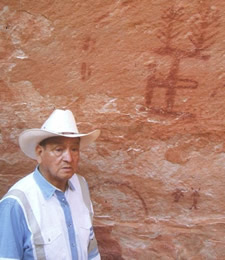Consultations
In the past it was common for field archaeologists to by-pass a rock art site in favor of another site type that was more familiar to the “dirt” archaeologist, less subjective or easier to record. This reluctance to engage rock art research may partially reflect a lack of education and understanding of how to record rock art sites. Julie Francis (2005) suggests that with a lack of training field archaeologists may feel inadequate or overwhelmed when they find a large rock art site. An immense effort is frequently needed to document a large rock art site. Completing adequate panel drawings can be a daunting task, especially for an archaeologist who lacks artistic skills. This is where Sacred Sites Research can help archaeologists who need sites adequately documented.
With the passage of American Indian Religious Freedom Act (US Public Law 95-341, 42 U.S.C. 1996 and 1996a) and parts of other federal codes, archaeologists are now obligated to consider the beliefs and opinions of American Indians regarding those sites. This federal legislation has had the effect of stimulating two significant incentives to advance rock art research. First, it has required field archaeologists to learn how to record a rock art site, or employ consultants who specialize in recording rock art sites. Second, it has opened a dialogue between American Indians and the archaeological community. This latter outcome has been good for the entire rock art community.
In general, twenty five years ago archaeologists and anthropologists did not believe American Indians retained any useful information on rock art sites. They reasoned that if Indians did tell you something about a rock art site, the information was so filtered through years of enculturation that it would fail to be of any value. Some archaeologists retain these ideas today. The facts are, however, that in the past decade or so of interaction with American Indians, archaeologists have learned significant information about rock art sites. Often times, the information is about something totally foreign to the archaeologist, like the presence of tobacco plants growing at the base of the rock art panel, information that becomes critical to understanding the images in the rock art.

GRANT BULL TAIL, member of the Crow Indian Tribe of Montana, United States is standing in front of a panel of painted figures that he recognized as part of the Crow Indian Sacred Tobacco Society.
Mr. Bull Tail offered details about the arrangement of the panel which presented archaeologists with a completely different explanation for the paintings
Sacred Sites Research is a non-profit (501c3) company.
Contact Us:
6220 Mojave Street NW
Albuquerque, NM 87120
Donate:
Sacred Sites Research, Inc. (SSR) undertakes funded projects at competitive costs, but SSR primary personnel do not receive salaries or compensation. Instead we use that money and the assistance of other volunteers to record rock art sites where no funding is available.
Support the protection and preservation of rock art sites. Your tax deductible dollars will be used saving rock art sites.
